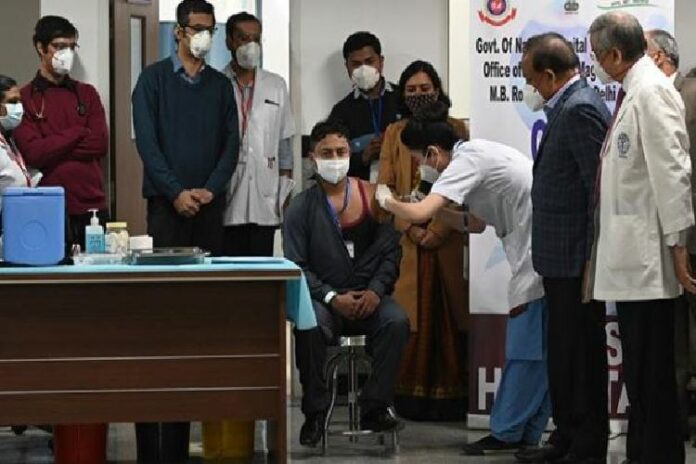Since Edward Jenner’s discovery of the cowpox vaccine in 1796 anti-vaccination arguments are frequently found in social literature. In the vacuum created by controlled media and filled by social media, the anti-vaxxer messages have got wings.
The rapid development of vaccines for the coronavirus has fuelled this hesitancy and myth. You might see your WhatsApp messages or Facebook, Twitter timeline filled with rumours, unscientific views, and lies. People on social media are more likely to see negative messages about vaccines than positive ones.
Disinformation and misinformation about vaccines can endanger lives—let us try to dispel some.
A vaccine uses your body’s natural defences to build resistance to specific infections by training your immune system to create antibodies, just as it does when exposed to a disease. As vaccines contain only killed or weakened forms of the germ, they do not cause the disease or put you at risk of its complications. The immune system remembers the germ, and if you are exposed to it in future your immune system can quickly destroy it before you become unwell.
“Adverse event following immunisation” (AEFI) is any untoward medical occurrence after immunisation, which is not necessarily caused by use of the vaccine. Most vaccine adverse events are minor and temporary in nature: such as a sore arm or mild fever. Only rarely do more serious adverse events occur: between one per thousands to one per millions of doses.
Myth: “Natural immunity is better than vaccine acquired immunity. A vaccine may weaken the immune system.”
Vaccines stimulate the immune system to produce an immune response similar to natural infection. They do not weaken or overload the immune system in any way.
If you wanted to gain immunity to measles by contracting the disease, you would face a 1 in 500 chance of death from your symptoms. In contrast, the number of people who have had severe allergic reactions to an MMR vaccine is less than 1 in 1 million.
Myth: “Vaccinations cause the diseases that they are meant to prevent.”
Vaccines mimic or imitate the diseases they prevent. The process of producing antibodies can sometimes cause a low fever or minor swelling, but not the actual disease.
Myth: “Vaccines contain unsafe toxins.”
Vaccines do contain trace amounts of formaldehyde, mercury and aluminium (as adjuvants which enhance the immune response) but only in trace amounts that are safe for children.
Myth: “The effectiveness of vaccination has never been proven.”
The number of cases for every vaccine-preventable disease plummets in the years after a vaccine for that disease is made widely available. Smallpox killed hundreds of millions of people and was one of the most feared diseases for over three thousand years. Today, thanks to immunisation efforts, it is completely gone. Polio and syphilis which once affected millions are rarely diagnosed now. Each year vaccination prevents 20–30 million deaths worldwide.
Myth: “Vaccines cause autism.”
There is no relationship between any vaccine and autism. Autism usually is determined before birth, well before any vaccinations are given.
The 1998 study which raised concerns about a possible link between the MMR (Measles, Mumps, Rubella) vaccine and autism was later found to be seriously flawed and fraudulent. The paper was retracted by the journal that published it, and the doctor who published it lost his medical licence.
Myth: “Not vaccinating my child affects only my child.”
Herd immunity means having a high enough percentage of people in a population who are immune to a disease so that there are few people left susceptible to infection.
But if the number of vaccinated people dips below the proportion needed to prevent an illness from spreading, a disease that was nearly eradicated can resurface with a vengeance, spreading quickly and threatening many lives.
Not getting vaccinated is like failing to stop at a chauraha, a four-way crossing. If three people stop and one doesn’t, the risk of an accident is relatively small. If two or three people don’t stop, the risk becomes much higher for everyone present.
Myth: “I know some kid who was vaccinated but got the disease.”
No vaccine is 100% effective. For reasons related to the individual, not all vaccinated persons develop immunity. Most routine childhood vaccines are effective for 85% to 95% of recipients. But 100% of children who were not vaccinated may get the disease, compared with 5–15% of those who were vaccinated.
Myth: “Infant immune systems can’t handle so many vaccines. The vaccine schedule is too aggressive and should be spaced out.”
The immunisation schedule is determined by decades of medical evidence on when vaccines are most effective in preventing these diseases. Infant immune systems are stronger: a baby would theoretically have the ability to respond to around 10,000 vaccines at one time. Babies are exposed to countless bacteria and viruses every day, and immunisation exposure is negligible in comparison.
Although there are more vaccinations than ever before, today’s vaccines are far more efficient. Small children are actually exposed to fewer immunologic components overall than children in past decades.
Myth: “Vaccines cause infertility.”
There is no scientific evidence to suggest that any vaccine could cause infertility in either men or women. I remember as a child I used to hear about the oral polio vaccine causing impotency, which had an enormous negative impact on the polio eradication drive, putting many lives at risk. The same lie is being propagated now about the Corona vaccine.
Myth: “If you’ve had COVID-19 already, you don’t need to get vaccinated.”
While a previous coronavirus infection might provide people with antibodies against reinfection, experts are not yet sure how long this protection lasts. The Center for Disease Control and Prevention suggests that “people may be advised to get a COVID-19 vaccine even if they have been sick with COVID-19 before”.
Myth: “Once you receive the coronavirus vaccine, you’re immune for life.”
It is not yet known how long immunity from a coronavirus vaccine will last, or whether it will need to be administered more than once, or even on a regular basis like the flu shot.
Myth: “Corona vaccines use a live version of the coronavirus.”
None of the vaccines use the live virus that causes COVID-19. The leading vaccine candidates use scientific techniques to train the human body to recognise and fight the coronavirus, by either introducing a killed virus or a harmless piece of the virus (not the entire germ) into the body.
Myth: “Corona vaccines can alter your DNA.”
While vaccines send genetic instructions to the body, these disappear quickly and do not alter your DNA.
Think of mRNA/dsDNA as an instruction manual. It directs the body to build an immune response to a specific infection. The time that this dsDNA/mRNA survives in the cells is relatively brief, in the span of hours.
What you are really doing is sticking a recipe card into the cell, to make a protein for a few hours.
Myth: “You don’t need both doses of Corona vaccines.”
You need both doses 3–12 weeks apart. The first shot starts building protection; the second shot boosts that protection.
Myth: “If you got the flu shot this year, you don’t need a coronavirus vaccine.”
While seasonal flu and COVID-19 share a similar list of symptoms, they are two different illnesses, caused by two different viruses.
Myth: “You can ditch your mask and forget social distancing after you get vaccinated with Corona vaccines.”
“A vaccine will complement the other tools we have, not replace them.” Contact tracing, testing more and more people, isolation, and quarantine for patients will need to continue. We have to continue to follow distancing norms, wearing effective masks, and practising hand hygiene.
India’s immunisation programme with the “Intensified Mission Indradhanush” strategy is the largest in the world, with annual cohorts of around 27 million infants and 30 million pregnant women receiving about 400 million doses over nine million sessions.
The whole program has been derailed because of the coronavirus pandemic. With a target to administer 500 million doses of a COVID-19 vaccine by June 2021 India must double up its already stretched vaccine delivery system, and also educate the under-informed and misinformed people in society.
Well planned and well implemented communication is an important way to limit the spread of rumors.
Takeaway Points
– There is no such thing as a “perfect” vaccine, which protects everyone who receives it and is entirely safe for everyone.
– Effective vaccines may produce some undesirable side effects which are mostly mild and clear up quickly.
– The majority of events thought to be related to the administration of a vaccine are not actually caused by the vaccine itself. Many are simply coincidental events, others are due to human or programme error.
– It is not possible to tell which individual might have a mild or serious reaction to a vaccine, although there are a few contraindications to some vaccines, to help doctors decide which individual might have a serious reaction.
By following the above contraindications the risk of serious adverse effects can be minimised. #KhabarLive #hydnews







